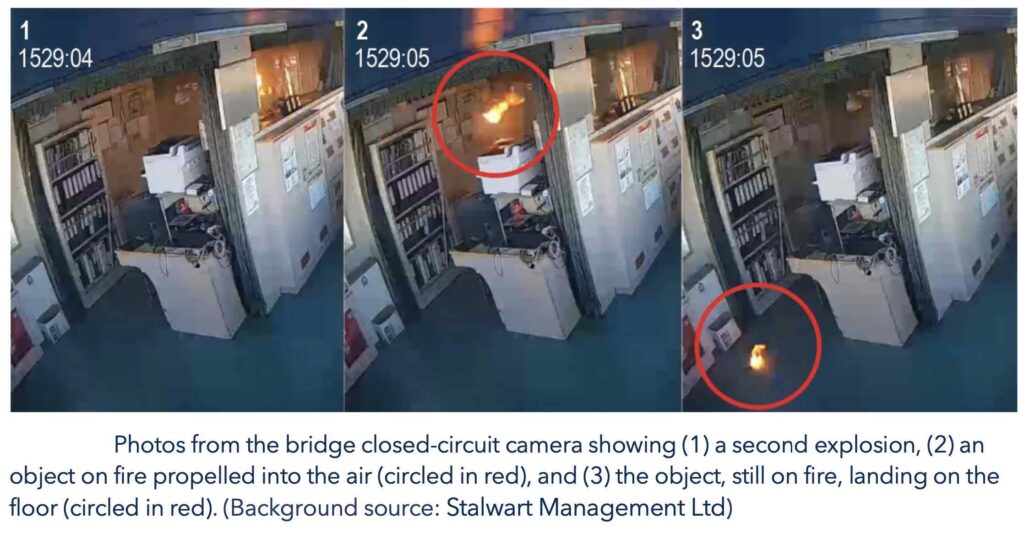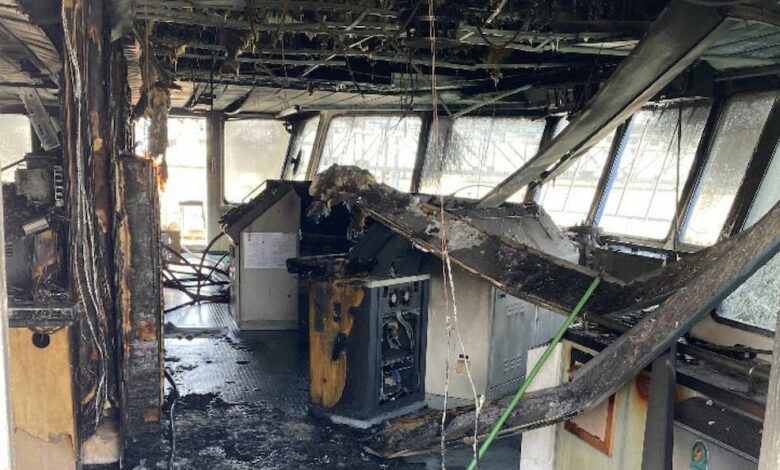You are here
How one handheld radio ripped a ship’s bridge apart
How one handheld radio ripped a ship’s bridge apart
Sam Chambers November 10, 2023 https://splash247.com/how-one-handheld-radio-ripped-a-ships-bridge-apart/
Lithium-ion batteries have been wreaking havoc on many ships in recent years, principally car carriers and containerships. However, even small batteries – powering a single handheld radio – can cause millions of dollars of damage.
The National Transportation Safety Board (NTSB) in the US has issued its report into the blaze on the bridge (pictured) of the crude tanker S-Trust 12 months ago. Investigators determined that the probable cause of the fire was the thermal runaway of one of the cells in a lithium-ion battery for a UHF handheld radio.
The S-Trust carried 20 ultra-high frequency (UHF) handheld radios for the crew to use to communicate during vessel operations. The two radios assigned to the bridge were a Motorola DP4400e radio (pictured), which used a lithium-ion battery, and a Motorola GP328 radio, which used a nickel-metal hydride battery.
Investigators found the remains of three batteries – one nickel-metal hydride and two lithium-ion – on the communications table. The single nickel-metal hydride battery was intact; one of the lithium-ion batteries was found intact in the remains of the chargers. Investigators only found components of the second lithium-ion battery.
Lithium-ion battery cell explosions are typically caused by a thermal runaway. An initial orange flash and puff of smoke caught on video feed at the time of the accident (see below) was likely the result of one of the missing lithium-ion cells exploding due to a thermal runaway.
As the fire expanded, the closed-circuit video captured a second flash, followed by a flaming object being propelled from the fire and landing on the deck of the bridge, where it continued to burn. This was most likely the other missing lithium-ion cell from the same battery. Based on the video, investigators determined that the second missing lithium-ion cell also experienced a thermal runaway, most likely initiated from the heat of the fire started by the initial battery cell thermal runaway.
Once the vessel was docked at the terminal and cargo operations began, the bridge watch ended, so no one was stationed on the bridge at the time the fire started. The first indication crewmembers had of a possible fire aboard was the loss of the closed-circuit camera feed to the monitor in the master’s office.
A thermal runaway occurs when a cell overheats and combusts; it is a chemical reaction that can occur to any type of battery cell if it is damaged, shorted, overheated, defective, or overcharged.
Crews can help prevent thermal runaways and ensuing fires, according to the NTSB, by following manufacturers’ instructions for the care and maintenance of lithium-ion batteries; properly disposing of damaged batteries; avoiding unsupervised charging; and keeping batteries and chargers away from heat sources and flammable materials.
Additionally, the NTSB advises companies should ensure that lithium-ion batteries and devices that use lithium-ion batteries are certified by Underwriters Laboratory or another recognised organization.
Should a lithium-ion battery fire occur, crews can attempt to extinguish the fire with water, foam, CO2, or other dry chemical or powdered agents. However, if the battery fire cannot be extinguished, personnel should attempt to allow the pack to burn in a controlled manner; this includes watching for nearby cells that may also experience thermal runaway and extinguishing other combustibles that may catch on fire.
The dangers of carrying lithium-ion batteries on ships were highlighted in an Allianz Global Corporate & Speciality report, which ranked fire and explosion as the number one cause of marine insurance losses by value from 2017 to 2021. The research, issued in November 2022, also revealed the growing threat of fires caused by lithium-ion batteries that are not stored, handled or transported correctly.

